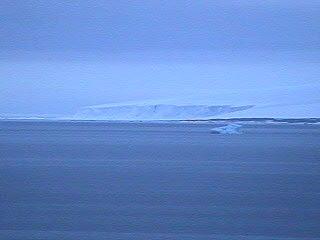
|
|
8 July, 2001
And Back Into the Ice
Sunday, 8 July 2001
God dag! (Good day!)
Life on Board
After the Open Water Station, we turned and headed back to the north,
looking for the Marginal Ice Zone again for our next station. We steamed
along, under overcast skies all day. At about 80o N/30o E, we passed to
the east of a small island. Just because it was something to look at other
than ocean, everyone was out on the decks taking pictures. There, I
learned that it is called White Island, the easternmost island in the
Svalbard/Spitzbergen archipelago. It has a rugged coast where icebergs
have broken off from the smooth dome glacier that covers the entire island.
It looks like a spoonful of vanilla ice cream after you take the first
mouthful (Can you tell what I am craving? There is no ice cream onboard,
at least none that I have been able to find. As a matter of fact, we
haven't really had any desserts at all. Swedish dessert usually consists
of a piece of fruit and some cheese. Who wants to eat that after you have
just had a big meal? I need chocolate!).
In 1897, a Swedish scientist named Saloman Andree launched a large gas
balloon from Spitzbergen in hopes of being the first person to reach the
North Pole. He reacted 40 tons of iron filings (Fe) with 40 tons of
sulfuric acid (H2SO4) to create enough hydrogen gas (H2) to fill the
balloon (Only a little explosive! And I'm sure he didn't mind dumping the
excess chemicals on the ground or in the ocean). Unfortunately, he didn't
account for the really cold and unstable air over the icecap and his
balloon crashed after 3 days. Andree and his 2 companions managed to walk
about 200 miles in 3 months to reach White Island where they died shortly
thereafter (Pierre Berton, Arctic Grail).
Scientists at Work
Today, all of the science groups prepared themselves for the 36 hour
Marginal Ice Zone station that will start at 4 am tomorrow morning. Many
will be working out on the ice as well as in the laboratories. When we are
on station, the scientists work very hard to collect their data while they
have the opportunity. Most just take short naps then return to the ice,
basically working straight through. All labs are on 24 hour a day
rotations so there are constantly people coming off the ice while others go
out (remember that it is always light!). Everybody is very tired but
realizes that they have to get their data first, then they can rest between
stations.
Where Are We Now?
As I write this journal, we are heading north/northwest along the top of
the Svalbard (Spitzbergen) archipelago, although there is no land in sight.
Current position is 81o56' N latitude and 26o29í E longitude and our land
speed as measured by my Garmin Global Positioning System (GPS) is about 11
miles per hour. I have no idea how many knots that is. We are breaking
through large, flat ice sheets, looking for open cracks (leads) in the ice
to make the ride smoother, but not always being successful. It is
drizzling outside so I know the air temperature is above freezing but JUST
barely. We passed by several seals hauled out along the open leads in the
ice. They raise their head to look at the ship, and, if they decide it is
safer in the water, they worm their way over to the edge, blubber rippling,
and slide into the water without a splash. The presence of seals means ice
bears are likely to be in the area so we kept our eyes peeled and were
rewarded with 2 sightings.
E-MAIL! I can read most of my email but I can't reply to each personally
due to the extremely expensive satellite time although I will reply to some
using this section of my daily journal. Thanks again to everyone for the
good wishes!
Chris Donovan: Thanks for the note. Polar bears are incredible to watch!
I will email Dr. Oechel at SDSU when I return to San Diego in the fall
(Please let him know I didnít have time before I left)
Bill Cleves: I am having I great time although it is probably I little
colder here than in Ireland. I think you are probably not working as hard
as I am either. Lot's o' love.
Scott McComb: Hello! Nice to hear from you. I hope you are having a good
experience in Alaska. This is a unique research expedition in that all of
the science teams are working together, keeping in mind that the end
product is an overall picture of what is going on from 100 m below the sea
surface to 2 km above the sea surface and how it all interrelates. I have
been taking and preparing seawater samples for a variety of analyses,
including chlorophyll and dimethylsulfide (DMS), which I will learn the
technique for tomorrow using Gas Chromatography (GC) to determine the
amount of DMS dissolved in seawater. DMS is important in the determination
of how much carbon dioxide is taken in by the plankton in seawater, which
affects the entire global climate cycle. Important stuff!
Vi ses! (See you later!)
From Deck 4 on the Icebreaker Oden,
Somewhere north of Spitzbergen,
Dena Rosenberger

Contact the TEA in the field at
.
If you cannot connect through your browser, copy the
TEA's e-mail address in the "To:" line of
your favorite e-mail package.
|
